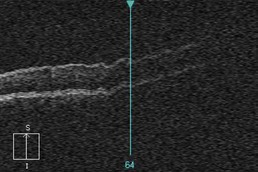Artifacts on OCT
▶ Mirror artifact (Fig 3.1.1): this artifact is unique to SD-OCT. It occurs when the area of interest to be imaged crosses the zero delay line and results in an inverted image. In practical terms, this happens when the OCT machine is pushed too close to the eye, or when the eye has pathology (e.g. retinoschisis or high myopia) in which a large axial range has to be imaged. The resulting image is inverted, partly inverted or may possibly have poor resolution.

Figure 3.1.1 Mirror artifact occurring in a case of retinoschisis (above) and a high myopic eye with a long axial length. The inverted image can be seen adjacent to the regular image.
▶ Vignetting (Fig. 3.1.2): this occurs when a part of the OCT beam is blocked by the iris and is characterized by a loss of signal over one side of the image.








